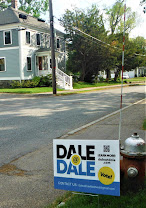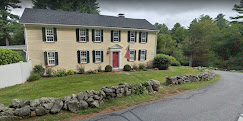 |
Norman Rockwell's
'Freedom of Speech' |
If you are reading this from anywhere outside New England, you
are likely familiar with the phrase ‘town meeting’ only from old Norman
Rockwell paintings or obscure novels. In my adopted town of Medfield,
Massachusetts, the town meeting is alive and well. Last evening, I witnessed a
demonstration of the power of the ‘direct democracy’* town meetings encapsulate.
Medfield - a thinly disguised 'Hardington' in seven of my mysteries - is justifiably proud of its school system, which is
consistently ranked as one of the best in the state. It has fewer than 3000
students in pre-kindergarten through twelfth grade, but delivers high quality
education on a budget of a little over $30 million a year.
 |
| The existing Dale Street School |
It also needs a new
elementary school. The Dale Street School is one of three in town and houses
students in the fourth and fifth grades. It dates to an era of heating oil at
twenty cents a gallon and classes in rigid rows of desks. Renovating the school
is not an option.
The question has always been where to build the new school
and, to a lesser extent, how large it should be. In any other time, there would
have been numerous public meetings to hear comments, ask and answer questions,
and gauge the direction of public sentiment. In an era of Covid, those meetings
were Zoom calls with little audience interaction. When there were questions,
too often the answer was ‘we’re still waiting for that information’. Apparently,
no one on the committee making the decision could sense the uneasiness or
frustration of the townspeople on the other end of those Zoom sessions.
 |
The Dale Street School is an easy walk
to the center of town |
There were always just two realistic site options. One would
be to build a new school on the same land as the existing Dale Street School,
which sits opposite the town’s school housing pre-K, kindergarten and Grade 1.
The site is easy walking distance to the center of town and is in the most
densely populated part of Medfield. The second option would be to build adjacent
the Wheelock School housing grades two and three.
 |
| The Wheelock School is in a rural area |
Each site has plusses and minuses. For the Dale Street site, it
would require two years of temporary classrooms while the new school was constructed,
but a lower overall cost because the school would tap into the town’s existing
infrastructure. For the Wheelock site, because of the rural setting, some $10
million of infrastructure would be required to accommodate the building, but
grades two through five would be housed on one campus.
The decision was made
by an 18-member School Building Committee which held, according to the school system's website, "seven public community
forums, 28 open meetings of full committee, 34 meetings of the Communications Subcommittee,
and 11 meetings of the Sustainability Subcommittee." All were held via Zoom.
 |
'Dale at Wheelock'. The new school is shown
behind the existing building |
It was only at one of its final meetings at the end of September
2020, the School Building Committee announced its decision and unveiled the
school’s design and price tag.
An $80
million facility would be constructed adjacent to the Wheelock School.
That is when, as they
say, all hell broke loose. One member of the Select Board was quoted in the local paper saying, “I
get the feeling it’s being jammed down their throats.” The Select Board member
also said, “I’m worried about support” of the project at the Town Meeting.
 |
| Signs were everywhere |
For the past seven months, the School Building Committee has
moved ahead assuming the hubbub would die down. At the same time, signs for an
organization called ‘Dale@Dale’ began appearing on lawns.
Their goal: to convince the School Building
Committee to reverse its decision.
The new school has always faced two hurdles. The first is a
two-thirds vote at a special town meeting, planned for this fall, to formally approve the project. The
second is a special election to approve higher taxes to pay for the school. If
either vote fails, Medfield goes to the back of the line for state funding that
would pay about $28 million of the cost, and the delay is usually measured in
years. A proposal for a new school in the nearby town of Hopkinton failed twice when residents balked at the price.
‘Dale@Dale’ successfully
petitioned to include an Article in the Warrant for last night’s Town Meeting.
Article 29 asked to see if the “Town will vote to recommend (the committees) amend
its proposal to the (state funding authority) to keep Dale Street School at its
current site.”
Over those months, using social media, mailed flyers, and
email exchanges, ‘Dale@Dale’ laid out its objections to the Wheelock site which
had been dismissed by the School Building Committee. The School Building Committee responded by
saying its decision-making process has been ‘completely transparent’, the town
had already spent $800,000 on design and feasibility studies, and any changes
at this point would derail the project’s funding.
 |
| Town Meeting was held on a football field |
Usually held in the high school gymnasium at 7 p.m., the Town
Meeting convened at 5 p.m. on the high-school football field. At the start of
the meeting, the temperature was about 75 degrees under sunny skies. By the
time Article 29 was brought up for discussion three-and-a-half hours later, the
temperature had dropped to 63 degrees and it felt ten degrees colder sitting
out on the field with social distancing. For 45 minutes, proponents repeated
their mantra: the site is fine and it is too late to change. Opponents countered
with their own studies and statistics, one of which was that, in two public surveys
conducted by the School Building Committee, respondents favored the Dale Street
site, as had the annual Town Meeting three years earlier.
To me, one of the most telling arguments was made by someone
who counted ‘more than 50 bikes’ out in front of the Dale Street School that
morning. The Wheelock site would be biking distance for only relative handful
of students, and walking distance for even fewer.
 |
| The one-lane bridge over Mine Brook |
I had my own reason for voting in favor of the Article, and it
has to do with human nature. The Wheelock school is located on Elm Street, possibly
the most scenic road in Medfield. It is a narrow, winding street dotted with Colonial
era homes, and a narrow bridge over a brook. If the Wheelock ‘campus’ comes
into being, it is only a matter of time before a group of parents begin advocating
– in the name of the children’s safety – to widen and straighten the road, add
sidewalks, and build a safer bridge. When that happens, the Elm Street I cherish
will disappear forever.
 |
The Henry Adams House on Elm St.
built in 1652 |
When the question was called, a show of hands did not make the
outcome clear. We then stood while ‘counters’ tallied row by row. In the end,
the vote was 229 in favor of the Article; 212 against. The Town has now voted to formally
ask the School Building Committee to reconsider its decision.
The vote also casts a long shadow over the
two future votes. As plebiscites go, it is one for the ages.
Will the School Building Committee change its mind? Will the
Select Board weigh in? A message from
one Select Board member this morning noted only that the vote was “basically
slightly favoring” the Dale Street location, and downgraded the language of the
Article to merely “an advisory ‘sense of the town meeting' opinion.”
Where will all this land? I don’t know. But I’m proud to live
in a place where direct democracy is still practiced. I wish more people had
that same opportunity.
----------------
* This is the primer for those of you who have forgotten what you learned in Civics or, worse, are of an age where Civics was no longer on the curriculum. We have what is called a 'representative democracy': we elect people who, in turn, make the laws we live by. The ancient Greeks had the real thing: a system in which every citizen (read 'adult, free-born male) was expected to show up and vote on whatever needed to be decided. When English colonists settled New England, they wanted a system that would bind the citizenry together. Thus was born the Town Meeting in which every citizen (read 'adult, land-owning male') got together at least once a year to approve budgets, enact laws, etc. The practice has been slowly dying out as towns got too large, or achieving a quorum became harder. Medfield (pop 12,000) is near the upper end of towns with Annual Town Meetings.



























